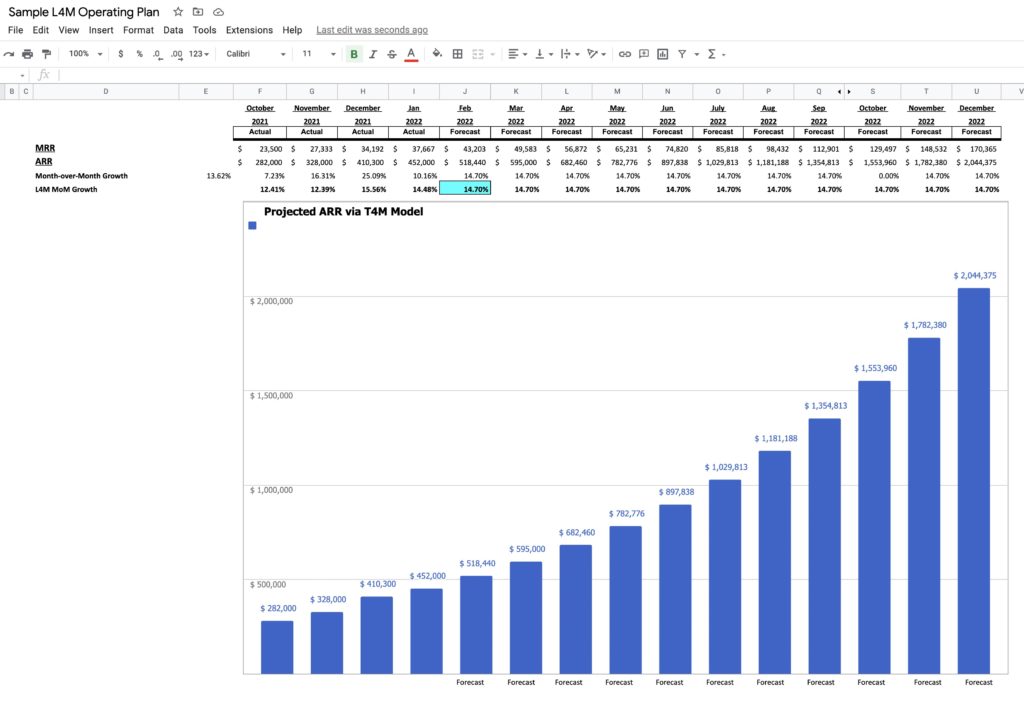Behind plan for the year?
Build a L4M Model — and share it. You probably won’t like it. And that’s the point.
“The Power and Honesty in a L4M Model. Build One Now.” https://t.co/Oedu6eCnOn
— Jason ✨Be Kind✨ Lemkin (@jasonlk) April 25, 2022
One thing I see most SaaS companies do a pretty poor job of until they have a great finance team is a go-forward model. A real financial model for the next year, and even just for the rest of this year. A basic, reliable model for how much you really will grow, and how much you really will burn.
It’s not that everyone doesn’t do some sort of financial model. Most do. It’s just … they tend to not really make any real sense.
Not when you do a deep dive and really probe the assumptions. If you went from $1m to $3m ARR this year … why exactly are you going to do $12m next year? The models sometimes tie, sort of … but they often aren’t really, well, “real”. And they are often late, and/or unfinished.
Even once start-ups have a strong finance team, the models they do make are often still … too rosy. They put in assumptions from VPs and even CEOs that, while plausible, aren’t really supported by trailing data or experience. Optimism is good. Delusion, though, can be dangerous. The classic one I see is hiring tons of reps or spending tons on marketing to magically grow faster than ever before. That can work. But putting it in your model for next year before you have any real proof points? Hmmm.
So let me make a simple suggestion. Build your financial model however you want. And whatever you do, use it to build your key goal for ARR at the end of the year.
But …
To keep you honest, and help the entire company and team keep track of how you are really doing … also build a simple, rolling, “L4M” (Last Four Months) model as well.
It will take just a few minutes. Then use it every month to track against your goal for year-end ARR. And I bet you it’s more accurate than your “real”, detailed model your finance team spent weeks or even months building.
An L4M Model? What’s that, you ask? Well, it’s simple. You take the average growth rate of the past four months. And roll it forward 12 months into the future. (L4M = “Last Four Months.”) Some folks that are familiar with a lot of modeling may also call it a T4M model (“Trailing Four Months”). Anyhow.
That’s it.
Like this:
All we did above was to average the month-over-month growth rate for the past four months. Which was 14.70%. And rolled that forward. To the end of the year. Which in this case, says we’ll hit $2.04m in ARR by the end of the year.
Then, do the same for your average burn rate from the past 3-4 months.
Maybe you don’t like this number. What it projects and what it says. Maybe your plan says $4m ARR for the year, but the L4M model says $2.5m after a tough quarter. Maybe you think the last month was an “anomaly”. That last quarter was soft. That it was your co-founder’s fault. That you got distracted with fundraising. That the move took up a lot of your time.
You know what? THE MODEL DOESN’T CARE. 🙂
That’s the beauty of it. For sure, you can beat it. But it speaks from truth. At least — this moment in time’s truth. And it takes just minutes to update each month.
It just takes your average from the last fourth months, and projects forward. It doesn’t really care if one month was soft. Because it averages four. It doesn’t really care if you didn’t hire fast enough. Because you should catch up over four months. It doesn’t have an opinion on … anything.
The key here is to update this every month. Which should take about 60 seconds. If you start to grow faster, the model will automatically scale up. If you have a few slow months, it will tell you that at least right now … you aren’t going to make the plan for the year. That we have to step it up.
And you can, and should, share this with the whole company and the board. Because it is, what it is. It’s not subjective. It doesn’t make excuses. And it doesn’t let you hide.
Do it. Add it as Slide 5 of your board packages, to every company meeting, to every update after you close out the month. Because it’s honest and it doesn’t judge. And don’t use it to criticize folks if you are behind the plan. You don’t even need to comment on it. It’s just what the trailing growth rate predicts. Everyone will get it.
And there will be fewer excuses.
You can do more than 4 months if you want, but too many more, and you start to go back too far in time. This doesn’t help in fast-growing companies. And you can do less than 4 months. But if you do, spikes will make it less predictive. Averaging the last four month’s revenue growth rate and burn rate is about right.
It predicts at least the next 9-12 months with startling precision.
(note: an updated SaaStr Classic post)


